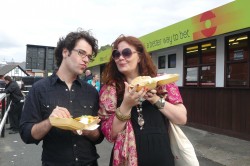
And they’re off! Three novice punters with little money and even less sense take a trip to Pontecarlo – aka Pontefract Races, the closest racecourse to Leeds. The result is this mini-guide to the ancient Sport of Kings, or one way of losing your money quicker than you can say ‘£10 on the near-sighted, 3-legged donkey, please.’
First you buy a race card, the essential guide to the meeting’s runners and riders. Ours turned out to be rather confusing and we didn’t understand a word of it. Ignoring the card, we chose our horses based not on their previous form but by their names, numbers and jockey’s silks (the funny outfits they wear). Thus, ‘I’m going for War Poet because I like Wilfred Owen’ or ‘Ooh, number 6 because, um, I live next door at number 8’ and ‘I’ll have that one because the jockey’s wearing purple.’ Our detailed analysis of the resulting data showed that the last of these is an absolutely foolproof strategy for winning tons of cash. Seriously.

Until quite recently, bookies communicated using a secret form of signing known as tick-tack. These days, like many things, the whole business is computerized. So the boards near the nice men where you go to throw away your money list the odds in LCD dots – 11/2 Lucky Windmill and the like. If you bet two pounds and your horse wins, you’ll get eleven pounds back – totally straightforward.
If, like risk-takers everywhere, you prefer your gambling to be thrilling but also more or less pointless, you look towards the more extreme odds – 66/1, for example, is usually a good starting point for a bad bet. It might be wise before race going to read the research into the psychology of gambling, which suggests that gamblers like to think that a) their choices are meaningful and b) they’re getting the hang of it. This means that if ‘your’ horse comes second in a race, you think it more likely that the one you bet on in the next race will win. Spoiler alert – it won’t.
Actually, it is possible to take money back from the bookies. Clancy won herself a tidy sum (based on the highly successful ‘the jockey wears purple’ strategy). Sadly, she had to blow most of it on drinks and fishcake and mushy pea butties to commiserate with us losers.
jockey wears purple’ strategy). Sadly, she had to blow most of it on drinks and fishcake and mushy pea butties to commiserate with us losers.
We learned a lot that day. One is that a budget is a good thing. Calculating in advance how much you can handle losing is the best way to approach proceedings. If you’re lucky, you’ll come home evens. Luckier still and you’ll leave the races with more in your wallet than you went with.
The second thing we learned is that it’s not about the winning (really!) but about the atmosphere. We had an amazing day: a band, some bookies, a few thousand people, the excitement of seeing the horses whizzing past the finishing post and a laugh with your friends is – to reclaim a term annoyingly appropriated by advertisers – priceless. So what if Zsolt and me lost our shirts? We’d budgeted for it…
Finally, we learned that some horses have really fancy bottoms. Who knew?

A typical view of race-going from a novice punter. I’m sure you had a lovely time and as you suggest, most people casually visiting the races under-prepared are more than likely going to lose money.
You can make money from horse racing, but not by randomly selecting horses based on silk colours or horse names. If you do your homework, learn what all those confusing things on the race cards are, only bet on runners that represent value and most importantly, keep your discipline, you can indeed make a profit. That 66/1 runner may be the value horse in the race if in reality it should be a 16/1 chance. The 2/1 favourite may not be value because its true price should in reality be 5/1.
There’s a good article about the value aspect of racing and betting in general here at CD Systems. It’s worth a read.
Wonderful beat ! I wish to apprentice whilst you amend your web site, how could i subscribe for a blog web site%3